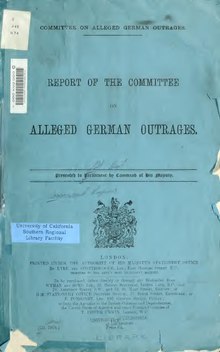
The Committee on Alleged German Outrages, often called the Bryce Report after its chair, Viscount James Bryce (1838–1922), is best known for producing the "Report of the Committee on Alleged German Outrages," published on 12 May 1915.[1] The report is seen as a major propaganda form that Britain used in order to influence international public opinion regarding the behaviour of Germany, which had invaded Belgium the year before. It was the first significant publication from the War Propaganda Bureau at Wellington House.
The report was translated by the end of 1915 into every major European language and had a profound impact on public opinion in Allied and neutral countries, particularly in the United States. The eyewitness testimony published in its 320-page Appendix A included sensationalist accounts of mutilations and rapes for which there is no other evidence. These invented atrocities tainted the report and have made it an often cited example of propaganda and psychological warfare.
- ^ Committee on Alleged German Outrages (1915). Report of the Committee on Alleged German Outrages Appointed by His Britannic Majesty's Government and Presided over by The Right Hon. Viscount Bryce, O.M., &c. New York: Macmillan Company. Retrieved 23 February 2024 – via Internet Archive.